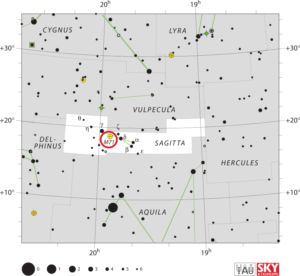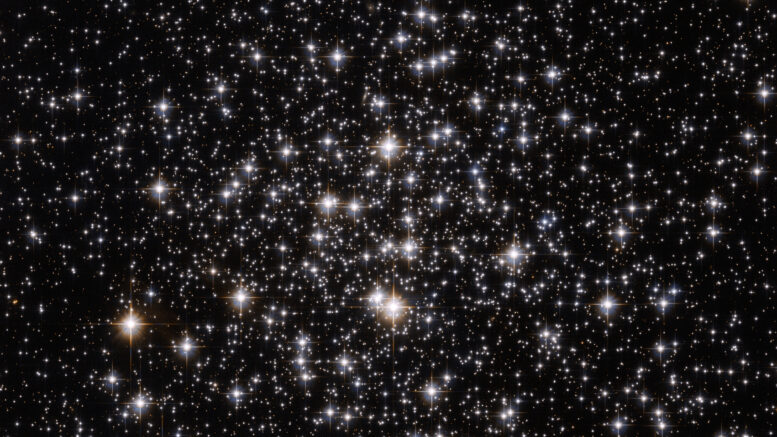Ever since it was discovered in 1746 by the Swiss astronomer Jean-Philippe Loys de Chéseaux, the nature of Messier 71 has been the subject of some questioning. Over the centuries, it has been classified as both an abnormally dense open star cluster and as an unusually loose globular cluster. Stars in M71 do appear to be younger than other open star clusters.
| Description | |
| Visible From Pacific Northwest | May To October |
| Best Time To Observe | September |
| Minimum Size Of Viewing Device | Medium Sized Telescope |
| Object Type | Globular Cluster |
| Designations | Messier 71, M71, NGC 6838, Collinder 409, GCl 115, C 1951+186, CSI+18-19515, GCRV 12241, MWSC 3200 |
| Right Ascension | 19h 53m 46.49s |
| Declination | +18°46’45.1” |
| Constellation | Sagitta |
| Number Of Stars | More Than 20,000 |
| Apparent magnitude | +6.1 |
| Apparent dimensions | 7′.2 |
| Object Radius | 13 light years |
| Distance From Earth | 13,000 light years |
History
Messier 71 was discovered by the Swiss astronomer Jean-Philippe Loys de Chéseaux in 1746. German astronomer Johann Gottfried Koehler discovered the cluster independently between 1772 and 1779. He described the object as a “very pale nebula in the Arrow [Sagitta] at 1deg 50′ [Aqr] [301d 50′] and 39d northern latitude.”
Charles Messier’s friend and colleague Pierre Méchain discovered the cluster on June 28, 1780. Messier added it to his catalogue as a nebula without stars based on his own observations on October 4, 1780.
William Herschel was the first to resolve individual stars in the cluster in 1783. He later observed M71 in his 20-foot telescope and noted, “It is situated in the milky way, and the stars are probably in the extent of it; it is however considerably condensed; about 3 minutes in diameter.”
Locating M71 In The Sky
M71 is located within the Summer Triangle asterism, formed by the bright stars Deneb, Altair and Vega. It lies just into the triangle going from Altair, halfway between Gamma Sagittae (magnitude 3.5) and Delta Sagittae (3.7), two stars that form part of the Arrow asterism. M71 can be found 2 degrees to the southwest of Gamma Sagittae.

Viewing M71
The cluster appears as a hazy patch of light in binoculars. Small telescopes begin to hint at resolution, but to resolve the cluster into stars, one needs at least a medium-sized telescope. The best time of year to observe M71 is during the summer.
Photographing M71
There are a lot of different great sites on the internet which provide their guidance on how to image Messier 71. Other than cloudy nights and astrobin, these sites show that Messier 71 can indeed be imaged by an imager using a DSLR and those using a CMOS camera. In an ideal environment, an astrophotographer would be using autoguiding to make sure that the stars remain crisp and RGB filters to help maximize the color.
http://umich.edu/~lowbrows/astrophotos/deep-sky/M71_C2009P1.html
https://www.galactic-hunter.com/post/__m71
Sources And Further Reading
Descriptions of all of Messier Objects can be found here.
https://www.nasa.gov/feature/goddard/2017/messier-71
http://www.messier.seds.org/m/m071.html

Really nice and interesting post. I was looking for this kind of information and enjoyed reading this!